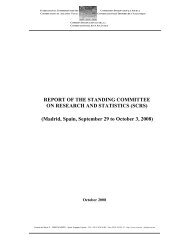REPORT OF THE 2008 ICCAT WORKING GROUP ON STOCK ...
REPORT OF THE 2008 ICCAT WORKING GROUP ON STOCK ...
REPORT OF THE 2008 ICCAT WORKING GROUP ON STOCK ...
Create successful ePaper yourself
Turn your PDF publications into a flip-book with our unique Google optimized e-Paper software.
WG Stock Assessment Methods – Madrid <strong>2008</strong>management procedures may be insufficient, by themselves, to provide adequate safeguard against the risk ofoverexploitation of tuna resources.2.3 Species-specific information2.3.1 BFT-E from vessel and farming listsRegarding the bluefin fisheries in the eastern Atlantic and Mediterranean, analyses were based on the <strong>ICCAT</strong>Record of BFT Fishing Vessels and BFT Farming Vessels. The metrics used to estimate capacity were numberof fishing and farming vessels by flag, fishing gear and vessel length categories (based on the categories used forthe Task I) and total hold capacity (m 3 ) of fishing and farming vessels by flag, fishing gear and vessel lengthcategories. Whenever tonnage (GRT, t) information for a particular vessel was not recorded in theaforementioned lists of vessels, it was estimated through the corresponding gear specific LOA length of vessel,(m) -GRT (t) relationship (see 2.1.1). Total GRT figures by flag and gear for both, fishing and farming vessels,were converted to hold capacity (m 3 ) assuming a conversion factor of 0.7 (2007 Assessment Methods Report).The number of fishing and farming vessels by flag, fishing gear and vessel length categories is shown in Tables5 and 6, respectively. Total hold capacity figures by flag and gear for both fishing and farming vessels are shownin Tables 7 and 8, respectively.As regards farming capacity for bluefin tuna in the Mediterranean, according to the <strong>ICCAT</strong> record of farmingfacilities (January <strong>2008</strong>), it has grown to about 59,842 t, which would represent approximately 48,000 t roundweight of (large) fish at time of capture (Figure 20). This estimated capacity is about 170% of the TAC agreedby the Commission at its Dubrovnik meeting in 2006 and represents a capacity excess of more than 32,000 tabove the predicted short-term catch level that would permit eastern bluefin tuna stock to rebuild to B MSY .2.3.2 ALB-N from vessel listThe Recommendation by <strong>ICCAT</strong> on Limitation of Fishing Capacity on Northern Albacore [Rec. 98-08] providesthat “...Contracting Parties, and non-Contracting Parties, Entities or Fishing Entities fishing for northern albacoreshall limit the fishing capacity of their vessels, exclusive of recreational vessels, for this stock from 1999onwards, through a limitation of the number vessels to the average number in the period 1993-1995. This listwas submitted by 1 June 1999 and every year since then. This applies only to those whose average catches aregreater than 200 t”. This list is reviewed each year in November and adopted by the Commission.According to <strong>ICCAT</strong> statistics, and the above criteria, those required to supply lists of such vessels are: Canada,EC, USA, and Chinese Taipei. In application of this Recommendation, Figure 21 summarizes the number ofvessels reported to <strong>ICCAT</strong> compiled as total, longline vessels and surface fisheries vessels operating in the NorthAtlantic and targeting albacore. For comparison reasons, the average number of boats for the period of reference(1993-1995) is included by the fisheries categories as longline and surface and total, and represented by thestraight line along the period. The first group of vessels in the graph represents the average number declared bythose countries/flags mentioned for the considered period 1993-1995.2.3.2.1 ALB-N evolution of number of vessels holding a licenseConsidering the available information for the northern Atlantic albacore stock, the number of vessels involved inthe exploitation of this stock is the most general measure of capacity at first step. Another type of informationextracted from the available data is the length of vessel (m) and the gross tonnage register (GRT) expressed inmetric tons (t).Since the beginning of the [Rec. 98-08] implementation there were a number of changes along the periodrecorded. As presented in Table 9, it is observed that those countries have been reporting the annual number ofvessels constantly along the period. The EC vessels apply to the surface fisheries (SURF) in the North Atlanticas shown in Figure 21. The surface fishery includes the following vessel gear type: baitboats, trollers, mid-waterpair pelagic trawl and drifnetters which were banned from January 1, 2002. On the other hand Canada, USA andChinese Taipei fleets apply to the longline vessels in the North Atlantic. Nevertheless, a number of recreationalvessels are included in this list of USA.8
















